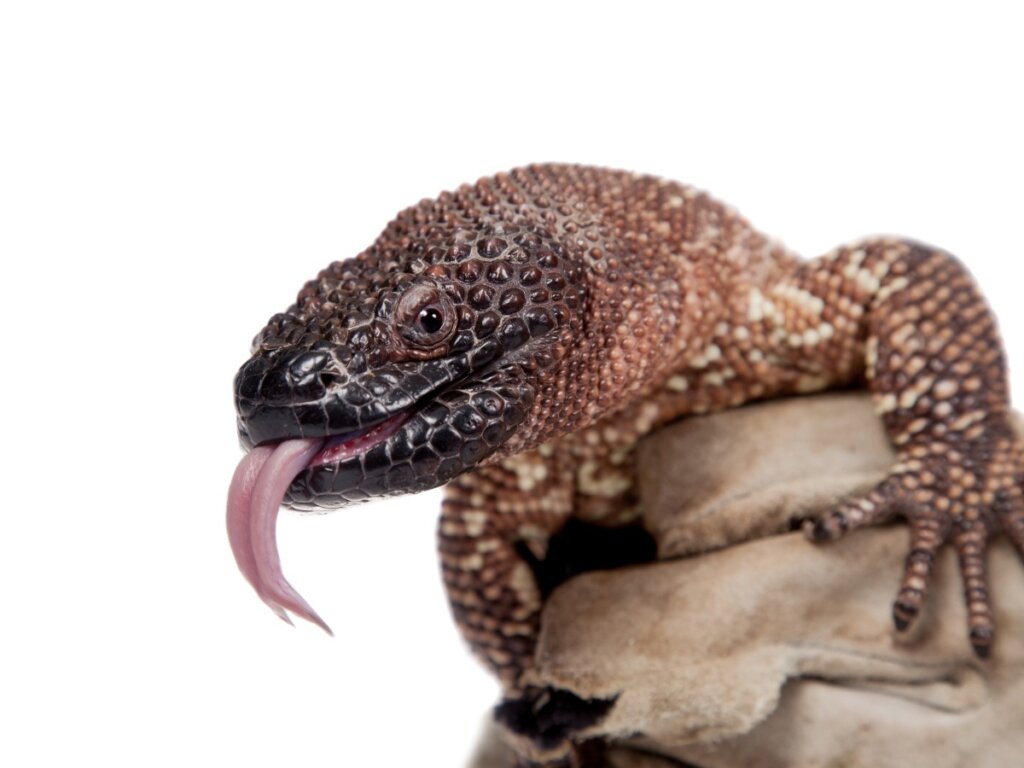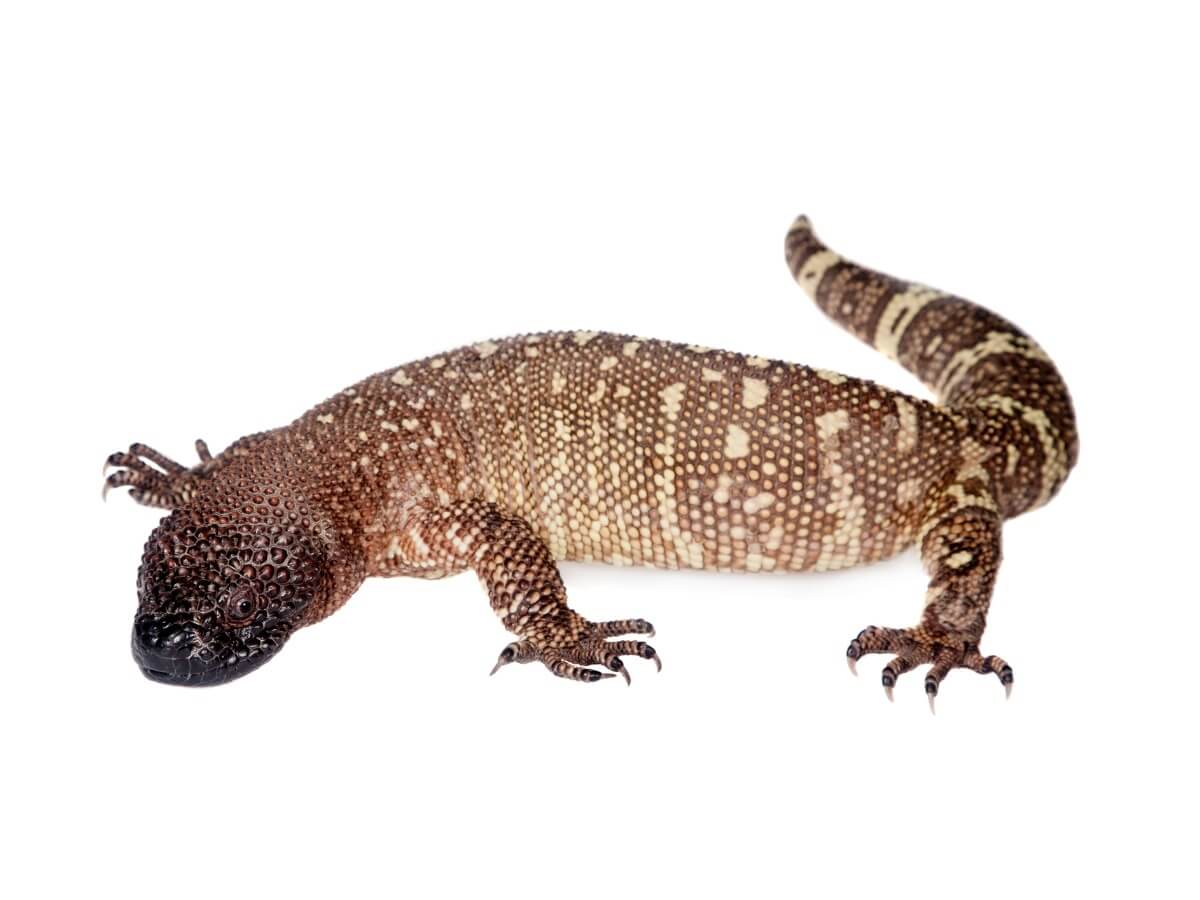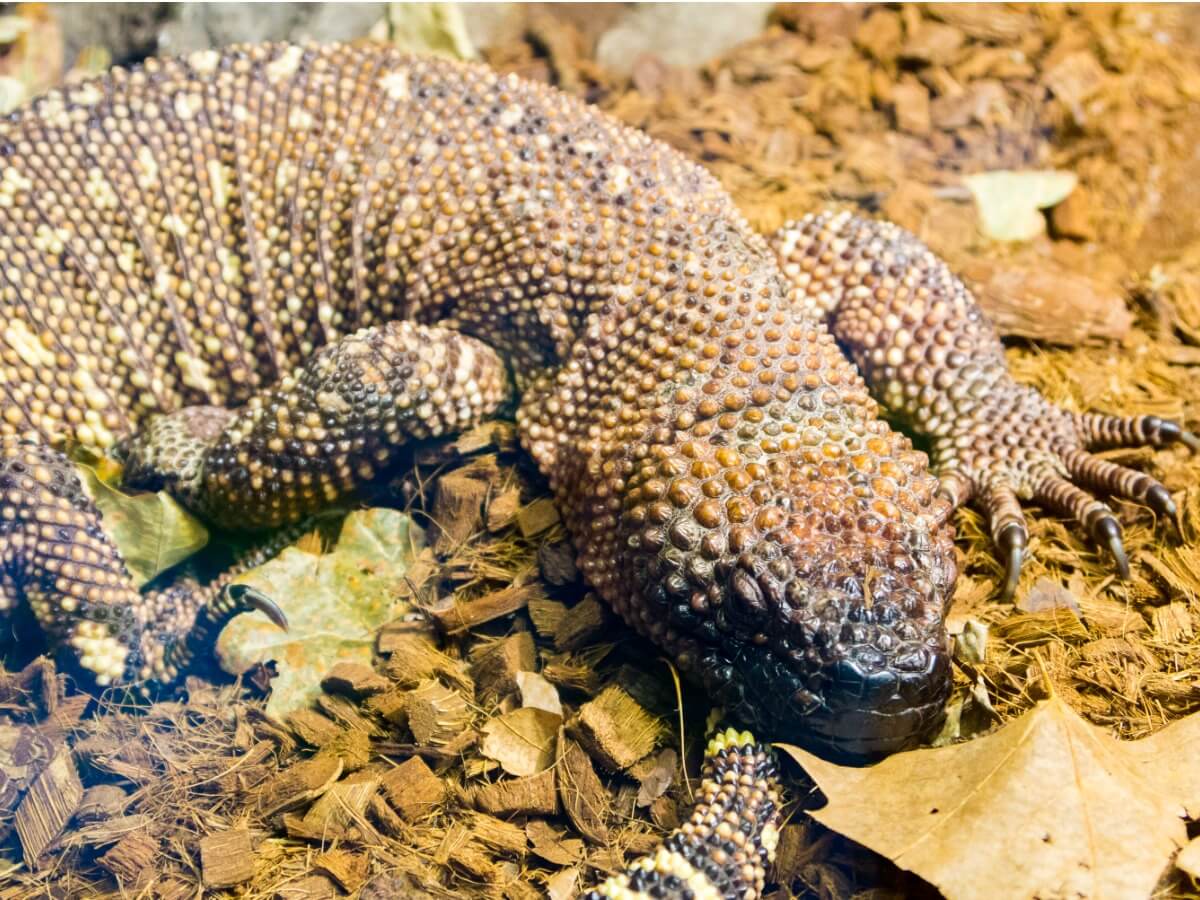The Mexican Beaded Lizard: Habitat and Characteristics

The Mexican beaded lizard is a rare peculiar reptile that we know very little about. Its skin is very particular, as it appears to be made up of beads, with simple but beautiful color patterns. In addition, it belongs to the only group of lizards that are capable of producing poison.
This animal is part of the Helodermatidae family, which includes lizards native to America. Specifically, we’re referring to Heloderma horridum, a reptile that, together with monitor lizards, represents the closest relatives of snakes. Read on to learn more about this fabulous reptile.
Habitat and distribution of the Mexican beaded lizard
This lizard is distributed in central and north America, being almost exclusive to Mexico, because it’s found along the coasts of the Pacific Ocean. In general, it can be seen from Chiapas to southern Sonora, including the Río Balsas area, within the states of Puebla, Oaxaca, Morelos, Guerrero and Michoacán.
The natural habitat of this reptile is composed of semi-arid and rocky environments, in which the vegetation is fragmented and separated, but which still has some open forests. Specifically, the ecosystem to which it belongs is known as a “low deciduous forest”, one of the most threatened worldwide.

Characteristics of the Mexican beaded lizard
This imposing animal has a cylindrical, robust and elongated body, which reaches 80 centimeters in length (2.6 feet), and weighs more than 800 grams (1.76 pounds). In fact, its robust tail represents almost 50% of its size, since it stores nutrients there to survive. Also, because its legs are short, it can’t move quickly, even in danger.
In addition to this, this reptile also shares a certain resemblance to snakes, due to its forked tongue, its fangs that function as needles, and the presence of venom. This sets it apart from most species in its group, as it’s one of the few lizards capable of synthesizing toxins and inoculating them directly.
On the other hand, its skin has granular and rounded scales that resemble beads. In turn, these same scales form a pattern of colors on its body, in which black predominates, with some yellow spots along its figure.
Behavior
Due to the way it behaves, this reptile appears to have nocturnal habits, as it hides in the ground during the day. Also, when it goes out, its movements are clumsy and slow, but it becomes more aggressive and active as the night progresses.
These animals only respond to confrontation in extreme moments, as their first option will always be to flee. However, due to its slow movement, they have peculiar behavior in which this lizard uses flexibility to its advantage.
At this time, if it perceives that it won’t be able to escape, the Mexican beaded lizard turns suddenly and bites the aggressor, something similar to the behavior of a dog.
Feeding of the Mexican beaded lizard
This reptile is a carnivore par excellence and its diet consists of small mammals, birds, lizards, frogs, insects and some eggs of other animals. In fact, like snakes, it swallows its prey completely, slowly digesting it internally. What’s more, in the extreme case that its food runs out, it can make use of the fat reserve in its tail to hold out for a while.
Although it may not seem like it, this animal is very careful when feeding, since when it consumes the eggs of other species, it does so in steps. In other words, it first pierces the egg a bit without breaking it, so that by holding it in its mouth it can easily crush it. This is very similar to when a chef cooks, tapping the shell a little to break it and be able to open it with his hands without any problems.
Reproduction of the Mexican beaded lizard
This reptile is viviparous and has a breeding season that takes place between February and March. Prior to this season, males must establish a hierarchy, which allows them to know who has the right to mate. In order to do this, they carry out a series of combats, in which they fight hand to hand, trying to pull and subdue the rival.
At the end of the matches, the winners are the only ones who will have access to the females.
With regard to mating, the species copulates in a session that can last between 30 and 60 minutes, ending with laying 2 months later. At this point, the female is capable of laying between 3 and 8 eggs, digging a hole 12 centimeters (5 inches) deep to protect them during their incubation.
Thanks to their burrow or cave, they’ll incubate for at least 6 months and small lizards of only 20 centimeters (8 inches) will emerge from the shells. As in other reptiles, this species doesn’t grant any kind of parental care to its young, since they abandon them shortly after spawning. The latter is not a big problem, since by not having many predators, your children can easily survive.
Conservation status
According to the International Union for Conservation of Nature, this reptile is classified as a species of “Least Concern (LC)”. However, this doesn’t mean that it isn’t threatened, since the population of these animals is reducing year after year. For this reason, local governments have proposed regulations to protect it, qualifying it as an “endangered” organism.
Apart from the destruction of its habitat, the biggest problems that this lizard faces are the mystical aspects that surround it. We’re referring here to the beliefs that revolve around its attractive and curious appearance, which, in turn, causes the trafficking and sale of this animal.
In some cases it’s caught to be used for medicinal and aphrodisiac purposes, which are attributed only by ignorance.

Unfortunately, the killing of exotic animals is related to the cultures that surround them. In this sense, because the species is unknown, they’re attributed mystical, aphrodisiac, and medicinal characteristics that lack evidence.
This is one of the reasons why scientific dissemination is so important: the objective is that we get to know more about what surrounds us, learning to respect it in the process.
All cited sources were thoroughly reviewed by our team to ensure their quality, reliability, currency, and validity. The bibliography of this article was considered reliable and of academic or scientific accuracy.
- Ariano-Sánchez, D., Muñoz-Alons, A., Marquez, L.C. & Acevedo, M. 2014. Heloderma horridum. The IUCN Red List of Threatened Species 2014: e.T9864A3152367. https://dx.doi.org/10.2305/IUCN.UK.2014-1.RLTS.T9864A3152367.en.
- Aguilar-Miguel, X. 2005. Heloderma horridum. Algunas especies de anfibios y reptiles contenidos en el Proyecto de Norma Oficial Mexicana PROY-NOM-059-ECOL-2000. Facultad de Ciencias, Centro de Investigación en Recursos Bióticos, Universidad Autónoma del Estado de México. Bases de datos SNIBCONABIO. Proyecto W035. México. D.F.
- Domínguez-Vega, H., Balderas-Valdivia, C. J., Manjarrez, J., & Monroy-Vilchis, O. (2018). Conociendo al lagarto escorpión: leyendas, realidad y potencial de una rareza biológica. CIENCIA ergo-sum, Revista Científica Multidisciplinaria de Prospectiva, 25(2).
- Beck, D. D., & Lowe, C. H. (1991). Ecology of the beaded lizard, Heloderma horridum, in a tropical dry forest in Jalisco, Mexico. Journal of herpetology, 395-406.
- Muñiz-Martínez, R., & Rojas-Pérez, M. A. (2009). Registro nuevo del escorpión mexicano Heloderma horridum (Reptilia: Helodermidae) en Durango, México. Revista mexicana de biodiversidad, 80(3), 871-873.
- Beck, D. D. (2002). Heloderma horridum. Historia natural de Chamela, 285.
